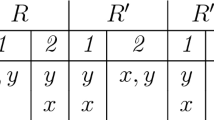Abstract
In this paper, we consider Nash implementability in general settings under the assumption that one may abstain. We show that in the case of at least two individuals, any social choice rule is Nash implementable by mechanisms with abstentions if and only if it is Nash implementable. Moreover, we introduce the notions of minimal participation and participation in equilibrium. We then study the possibility of Nash implementability by mechanisms that satisfy minimal participation or participation.
Similar content being viewed by others
Notes
If \(F\) satisfies monotonicity and no veto power, we can choose \(B=A\) and \({C}_{j}\left(a,\theta \right)={L}_{i}(a,\theta )\) in \({\Gamma }_{n}\).
References
Artemov, G. (2015). Time and Nash implementation. Games and Economic Behavior, 91, 229–236.
Benoît, J.-P., & Efe, A. O. (2008). Nash implementation without no-veto power. Games and Economic Behavior, 64, 51–67.
Bergemann, D., & Morris, S. (2008). Ex post implementation. Games and Economic Behavior, 63, 527–566.
Bochet, O. (2007). Nash implementation with lottery mechanisms. Social Choice and Welfare, 28, 111–125.
Cengelci, M. A., & Sanver, M. R. (2007). Is abstention an escape from Arrow’s theorem? Social Choice Welfare, 28, 439–442.
Dokow, E., & Holzman, R. (2010). Aggregation of binary evaluations with abstentions. Journal of Economic Theory, 145, 544–561.
Dutta, B., & Sen, A. (1991). Necessary and sufficient conditions for 2-person Nash implementation. Review of Economic Studies, 58, 121–129.
Dutta, B., Sen, A., & Vohra, R. (1994). Nash implementation through elementary mechanisms in economic environments. Economic Design, 1, 173–203.
Eliaz, K. (2002). Fault tolerant implementation. The Review of Economic Studies, 69, 589–610.
Jackson, M. O., & Palfrey, T. R. (2001). Voluntary implementation. Journal of Economic Theory, 98, 1–25.
Korpela, V. (2013). A simple sufficient condition for strong implementation. Journal of Economic Theory, 148, 2183–2193.
Lombardi, M. (2012). Nash implementation via simple stochastic mechanisms: strategy space reduction. Review of Economic Design, 16, 297–309.
Lombardi, M., & Yoshihara, N. (2013). A full characterization of Nash implementation with strategy space reduction. Economic Theory, 54, 131–151.
Maskin, E. (1999). Nash equilibrium and welfare optimality. Review of Economic Studies, 66, 23–38.
Maskin, E., & Moore, J. (1998). Implementation with renegotiation. Review of Economic Studies, 66, 39–56.
Mckelvey, R. (1989). Game forms for Nash implementation of general social choice correspondences. Social Choice and Welfare, 6, 139–156.
Mezzetti, C., & Renou, L. (2012). Implementation in mixed Nash equilibrium. Journal of Economic Theory, 147, 2357–2375.
Moore, J., & Repullo, R. (1990). Nash implementation: a full characterization. Econometrica, 58, 1083–1100.
Palfrey, T. R., & Srivastava, S. (1991). Nash implementation using undominated strategies. Econometrica, 59, 479–501.
Quesada, A. (2005). Abstention as an escape from Arrow’s theorem. Social Choice and Welfare, 25, 221–226.
Repullo, R. (1987). A simple proof of Maskin’s theorem on Nash implementation. Social Chioce and Welfare, 4, 39–41.
Saijo, T. (1988). Strategy space reduction in Maskin’s theorem: sufficient conditions for Nash implementation. Econometrica, 56, 693–700.
Saijo, T., Tatamitani, Y., & Yamato, T. (1996). Toward natural implementation. International Economic Review, 37, 949–980.
Sjostrom, T. (1994). Implementation by demand mechanisms. Economic Design, 1, 343–354.
Tatamitani, Y. (2001). Implementation by self-relevant mechanisms. Journal of Mathematical Economics, 35, 427–444.
Yi, J. (2011). Implementation via mechanisms with transfers. Mathematical Social Sciences, 61, 65–70.
Author information
Authors and Affiliations
Corresponding author
Additional information
Publisher's Note
Springer Nature remains neutral with regard to jurisdictional claims in published maps and institutional affiliations.
Rights and permissions
About this article
Cite this article
Yi, J. Nash implementation via mechanisms that allow for abstentions. Theory Decis 91, 279–288 (2021). https://doi.org/10.1007/s11238-020-09790-0
Accepted:
Published:
Issue Date:
DOI: https://doi.org/10.1007/s11238-020-09790-0



